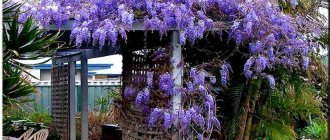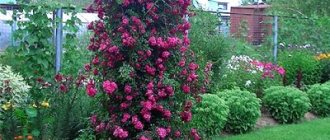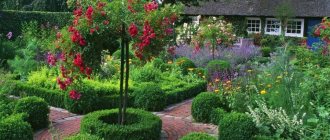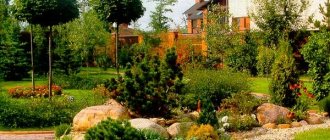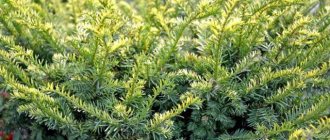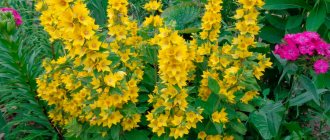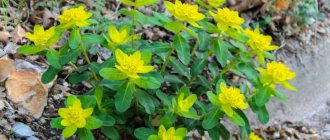Every owner of a country house wants the surrounding area to be beautiful and cozy. Many people arrange beautiful flower beds or plant an entire garden. Of course, all this requires a lot of effort and trouble. However, you can decorate some buildings with plants, for example, a gazebo.
In this article, we will look at all the features of how to decorate, as well as which climbing plants to choose and plant for the gazebo. Thanks to them, you can add freshness and splendor to your favorite vacation spot.
Elements for landscaping
Perennial climbing plants are the ideal solution for this. They can beautifully landscape the gazebo area. These plants will allow you to envelop any building on your summer cottage: a terrace, veranda, and even a gazebo. There are many beautiful climbing flowers that will give the gazebo a unique beautiful look.
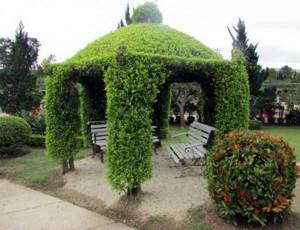
It is worth noting that such plants will not only serve as decoration, but also as additional protection. For example, grown climbing plants will protect the recreation area from sunlight, dust, wind, etc. Also, such a hedge will muffle all sounds from the outside. Thanks to this, comfortable conditions for staying in it will be created inside the gazebo.
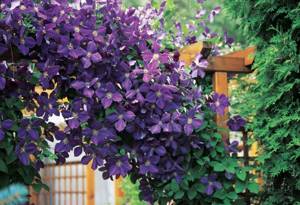
Pergola materials
Today there are companies on the market from which you can buy ready-made structures. But more often they are designed and built directly on the site. This approach is preferable, since the landscape architect, when drawing up the project, will not only take into account the wishes of the customer, but will also organically fit the structure into the surrounding landscape.
Before starting design, in addition to functionality and dimensions, it is necessary to decide on the materials for the frame. They are usually selected to match the style of the house and landscape design, but performance characteristics are no less important.
Stone and brick
Columns made of natural stone or clinker bricks look solid and give the building a southern flavor. They are strong and durable, but too massive, so they are usually used in garden ensembles and almost never in small private gardens. An exception may be a large country mansion with a spacious garden, decorated in a Mediterranean style.
Metal
Metal structures are lightweight, durable, aesthetically pleasing, and require minimal maintenance. To resist corrosion, they are most often made of galvanized steel, aluminum, or metal with a moisture-resistant polymer coating. Such buildings will be appropriate in exteriors decorated in laconic modern styles - high-tech, minimalism, modern.
The openwork forged structures stand out, ideal for gardens in a romantic, landscape style.
Aluminum arches are excellent for constructing enfilades
Tree
Wooden frames are more common than others. This material is warm and lively, it looks natural in the garden, plants love it. To make the structure durable, choose hard types of wood, such as larch and cedar.
Wooden pergola is an ideal solution for traditional landscape design styles - landscape, country, English gardens
Combination of materials
Often designers offer design options that combine various materials. The building with stone pillars and wooden floors looks organic. Wood goes well with metal and clinker bricks.
Wooden pergola is an ideal solution for traditional landscape design styles - landscape, country, English gardens
Parthenocissus or maiden grape
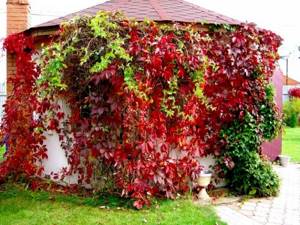
In the summer, this plant will reliably protect the gazebo from the scorching rays of the sun and provide sufficient shade. Rich green five-part leaves will decorate the gazebo even in the autumn season. Parthenocissus will be covered in beautiful bluish-black berries in the fall. The result is a living decor.
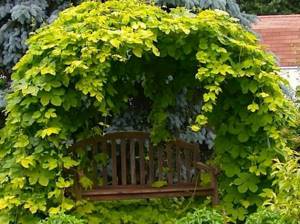
As for cultivation, this fast-growing climbing plant is not at all fussy. During the first year, it must be watered abundantly. As for subsequent years, it practically does not require special care. Moreover, it develops successfully both in direct sunlight and in the shade. There is no need to additionally protect the climbing plant from frost in the winter.
Advice! The only thing that needs to be done when caring for climbing vines is to cut off the extra vines that extend beyond the arbor.
Wisteria or wisteria
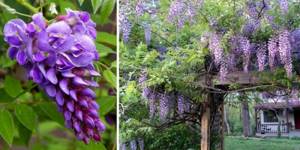
Today, breeders have developed such varieties of subtropical wisteria that they can even withstand frosts down to -40°C. In particular, this is the Blue Moon Wisteria Macrostachia variety. This variety can now be planted in the middle zone. This climbing plant will perfectly decorate columns in arbors with its delicate bluish-purple flowers.
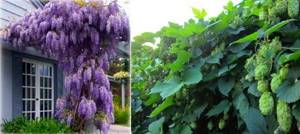
After planting wisteria, it should be constantly watered until the end of summer. This is necessary for the plant to develop in moist soil. However, it should not be very wet. When it comes to mid-September, watering should be reduced beforehand. If you want spectacular flowering, then during the growing season the soil should be fed once every seven days. Both organic and mineral fertilizers should be used as fertilizer. When decorating a veranda and gazebo, the plant should be regularly tied and guided.
Climbing plants for the gazebo that require care
Professional gardeners decorate gazebos with plants that are quite demanding to care for.
They are distinguished by stunning decorative properties and beautiful, abundant flowering . But it is very difficult to grow and preserve such species, so when choosing, you need to pay attention to the environmental conditions in which they will grow, namely:
- Soil fertility;
- Average summer and winter temperatures;
- Light level;
- Drafts and wind direction.
Let's look at the most famous specimens from this group.
climbing roses
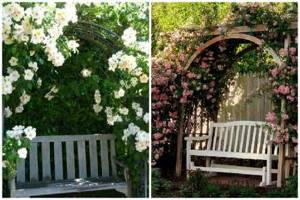
The lashes grow up to 9 meters in length. It is advisable to provide additional support for them, especially during flowering, when the emerging buds add weight to the green mass. A climbing rose can bloom once a year or delight the eye with flowering all season long - it depends on the specific species.
The plant requires plenty of light throughout the day. Also, the landing site should be well ventilated. Excess moisture is detrimental to the roots, so the close proximity of groundwater to the soil will have a bad effect on the condition of the plantings. The growing substrate must be fertile.
To carry out proper care, you must regularly do the following:
- Loosening the soil;
- Application of fertilizers;
- Pruning as it grows;
- Proper watering;
- Treatment for fungal diseases and parasites;
- Shelter from frost due to poor resistance to cold.
Clematis
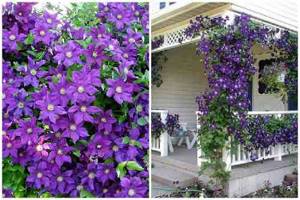
It is a climbing plant of the Ranunculaceae family and is perfect for decoration due to its abundant flowering. Such flowers for a gazebo will make it a true work of art. A young specimen that was recently planted does not tolerate bright sun, so it is advisable to shade it. Clematis care includes:
- Application of fertilizers;
- Constant weeding;
- Loosening the soil;
- Attaching growing shoots to a support.
The “green resident” does not like very moist soil, although it requires regular watering. It also needs to be protected from drafts, and before the winter period a light shelter must be made.
Decorative pumpkin
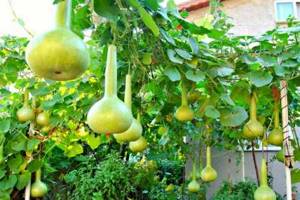
Decorative pumpkin has beautiful leaves and is one of the fruit varieties of climbing plants that can be used to attractively decorate a gazebo. Such green space in the fall can give a good harvest. But pumpkin fruits are also inedible, but simply decorative varieties.
Wisteria
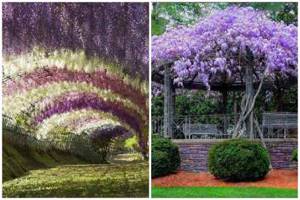
Japan is the homeland of wisteria, and this “green pet” is valued for its flowering period, when hanging clusters of different shades (white, lilac, purple, pink) form on the vines. One such bunch can be up to 0.5 meters long. It will effectively decorate not only arched structures (which are most suitable for them), but also a gazebo. All varieties are not resistant to winter cold, except one - “Blue Moon”. The blue clusters of this vine tolerate frost down to -30 degrees;
Honeysuckle and actinidia
They bring fragrant and tasty fruits to the table and create a decorative wall from vines. Actinidia fruits taste like kiwi. Honeysuckle berries rich in vitamins are used to make preparations for the winter in the form of jam, compote, preserves, which are similar to cherry in taste and color.
Akebia
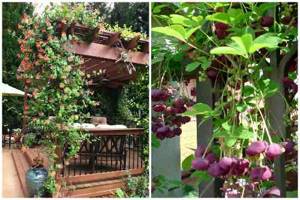
Akebia is a plant that has recently begun to spread throughout Russia. The shape of the akebia fruit is similar to a mango, and its purple color resembles a plum. This liana blooms in May, bears fruit from August until almost the end of October, and has sweet, tasty, sticky pulp. This specimen is extremely rare for sale; it is better to purchase its seedlings in large nurseries.
Baljuan knotweed
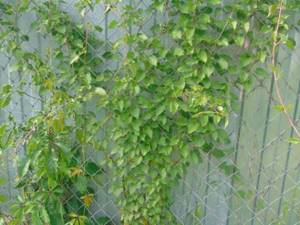
Another variety of climbing plants for the gazebo can be considered Baljuan knotweed. Over the course of one year, the growth is about 5 meters. Plus, Baljuan knotweed is distinguished by its abundant and beautiful flowering. This will be a real decoration for an open gazebo. The flowers are white with a pink-lilac tint.
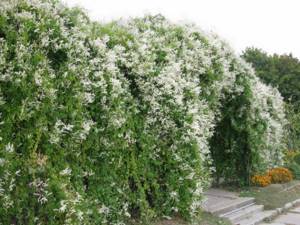
There are some features of its cultivation. This plant is sun-loving. For this reason, it should only be planted if the gazebo is located on the sunny side. If the Baljuan knotweed freezes in winter, it will be able to fully recover in the spring.
Honeysuckle Honeysuckle
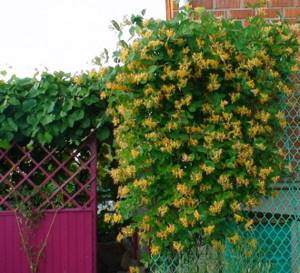
This plant has attractive numerous tubular flowers (during the flowering period). This flower is quite whimsical, however, all worries about its care are more than offset by the beauty of this plant. The thing is that honeysuckle needs regular watering, as well as fertilization.
As for the color of the flowers, this is a whole landscape of colorful flowers. They have a pleasant aroma. A fresh and delicate smell fills the gazebo without being annoying.
Selection of annual plants
Already from the name it is clear that these climbing ornamental plants for the garden will delight only from spring to autumn, and will die with the first frost. But they have a significant advantage - you can quickly get whole waterfalls of flowers of different shades, shapes and smells, which landscape designers successfully use when creating vertical gardening.
So, if you need to quickly get a green mass strewn with flowers on a gazebo or pergola, then we definitely choose annuals - they will cover up design defects, give an aesthetic appearance to the gazebo or pergola, and fill the resting place with aromas.
Types of annual climbing plants for the garden:
- morning glory;
- sweet pea;
- dolichos;
- nasturtium;
- kobeya;
- decorative beans.
morning glory
C is the most favorite unpretentious plant from the bindweed family, capable of truly entwining anything with bindweed. Especially loves the sun and vertical supports. And she doesn’t care whether it’s the wall of the gazebo, a rose or a tree growing nearby - as long as she climbs up. Therefore, when planting, you should take into account this passion of the flower.
With 530 species, there is plenty to choose from. The flower, which is a slightly inverted funnel with curved edges, can be large, up to 10 centimeters in diameter, medium, up to 7 centimeters, and small, up to 5 centimeters - you can choose any size to your taste.
The colors and their combinations represent such a diverse range that you simply get lost. The palette begins with pure white shades and gradually ends with dark blues. But the flowers can be striped, burgundy with a transition to purple with a blue edge, or with a bright border and a dark center.
Imagine how it looks against the backdrop of heart-shaped green leaves. Please note that you can admire flowers only in the first half of the day, especially in the morning. They will then close until the next day. You also need to know that morning glory is poisonous, which means that safety measures will not hurt. But if you don't chew it, nothing will happen.
Care is very simple and consists of timely watering and fertilizing with liquid complex fertilizer once every 10 days.
Sweet pea
Many people treat him indifferently, but in vain. English garden designers have made this flower from the legume family their calling card. Do you think it's just like that? And poets are delighted with him. Provence style is generally unthinkable without sweet peas. Why has this plant so fascinated many of its admirers?
1000 varieties, 10 main varietal groups, hundreds of shades: from white to dark hyacinth. But the main thing is a very elegant brush shape and an indescribable delicate aroma, picturesque design of the gazebos, flowering all day and all summer. Perhaps this is why varieties of sweet peas are grown in our country not as climbing plants for the garden, but for cutting into bouquets. This is a kind of natural deodorant that spreads the aroma from spring until the first snow.
For gazebos, choose tall types, reaching two meters in height, medium ones - up to one and a half meters and low ones - up to 80 centimeters. Using different heights and colors, you can create a real impressionist painting at the entrance to the gazebo.
The plant is very resilient, blooms first and ends flowering last, loves sunny places, garter to a support, rare but abundant watering. It feels great against the wall of the gazebo, which protects it from the wind.
Sweet peas will not bother you with special care - you just need to plant them and water them from time to time.
Dolichos
This plant is adored by Indian cooks, and gardeners call it hyacinth bean or climbing lilac. You've probably seen and admired the beautiful hanging racemes with many colorful moth-shaped flowers.
Given the rapid growth (and some varieties reach a length of four meters), large picturesque leaves and luxurious clusters of flowers from summer to autumn, designers often use dolichos in the design of pergolas and gazebos. And after flowering, the pods look very decorative against the background of green to purple leaves.
Care is simple and consists of watering and occasional fertilizing, but it must be taken into account that this is a heat-loving plant, so it should be planted after frost, choosing a place on the sunny side.
Nasturtium
Annual climbing plants for the garden in golden tones are represented by nasturtium. Over the summer, shoots grow up to three meters. They are simply strewn with gramophones up to six centimeters in diameter from golden yellow to dark orange. Flower growers have even developed a variety with a lavender color.
The aroma is delicate, with a slight bitterness, pleasant, but it repels flies and mosquitoes - this property can very well be used when decorating a gazebo.
This is the most unpretentious of all climbing plants for the garden, which does not really like sunny places. For lush growth and flowering, infrequent watering and tying to a support are sufficient.
Kobeya
If climbing plants for the garden decide to organize a beauty contest, then the winner among annuals will undoubtedly be kobeya. Its delicate, large, up to eight centimeters in diameter bells from white to deep purple flowers, sitting on a rosette of dark green leaves, will charm anyone. Moreover, on the vine you will immediately see white flowers, and as they open, a smooth transition to dark violet.
The shoots grow very quickly and reach four meters, and they very persistently climb everything they manage to cling to with their tendrils. The plant looks amazing. Imagine how cool the support of a pergola or the wall of a gazebo looks with large bells. By the way, they will bloom all summer until frost.
Kobeya is unpretentious, but will require fertilizing with complex fertilizer once every ten days and constant watering. And if you dig it up in the fall and store the roots in a flower container over the winter, then from an annual it can completely turn into a perennial plant.
Decorative beans
Landscapers, when choosing climbing plants for the garden, often use decorative shade-loving beans as a backdrop for brighter flowers, decorating gazebos and pergolas. Please take note of this and maybe you will use this idea.
Long, up to four meters, shoots provide dense cool shade, and the presence of multi-colored flowers in the shape of a sailboat, blooming profusely all summer until October, and pods allow you to combine business with pleasure - grow flowers and vegetables at once. Moreover, a decent harvest of beans can be harvested - up to 2 kilograms from 1 square meter of area.
Maintenance is minimal: just water and remove weeds. There is no need to rush sowing; be sure to wait for warm weather, as frost will destroy the seedlings. But this is the only condition for growing.
Clematis
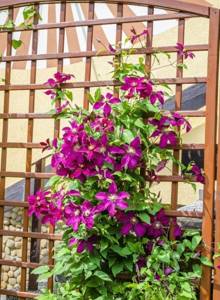
The perennial decorative vine has flowers of different sizes and colors. Flowering is observed for three months. However, in order for this plant to develop well, it must be planted on the sunny side. This light-loving vine grows very slowly in the shade. Clematis blooms in different inflorescences. If you have a closed gazebo and you open the windows and doors, the interior will be filled with a pleasant aroma.
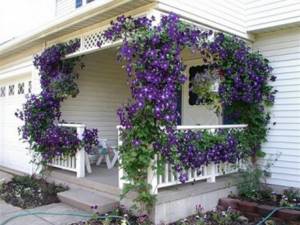
climbing roses

The rose is considered the real queen of any garden. And if you plant it near the gazebo, it will be a very impressive picture. A sea of roses will decorate the building and fill the entire area with a pleasant aroma. Very often this plant is used for vertical gardening. One rose shoot can reach up to 15 meters.
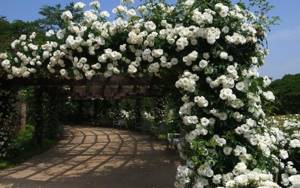
It is no secret that there are a huge number of varieties of Roses and regardless of the one you use, this flower will adequately decorate your gazebo. Rose flowers bloom until late autumn; they are not even afraid of the first frosts. In any case, this is a win-win option, since while communicating or relaxing in the gazebo, you can enjoy the wonderful aroma of roses.
Ranks
Chins are the same as sweet peas. Maybe both one-year-old and two-year-old. Grows well in temperate climates. More than fifty varieties of this climbing flowering herb are found in the CIS countries. Ideal for vertical gardening.
It is not only a green decoration, but also a fodder grass. It is fed to domestic animals, and casein is extracted from the seeds.
The ranks reach one hundred and fifty centimeters in height. This allows them to be used as pergola plants. But, they need to be combined with other types. Stems can be climbing or erect. The leaf ends in a spine or tendril. The flowers are beautiful, large, very bright. Can be white, blue, purple, pink, lilac. The seeds also come in different shades.
Chins tolerate shadow well. But in the twilight they will reach for the sun and may not produce flowers. If the temperature changes sharply, the resulting buds will fall off. Avoid planting china too early in the soil. They are not picky about soil. Choose neutral soil. They do not require feeding. But watering should be sufficient, especially on hot days. Chins cannot tolerate drought. If you planted a perennial species, you don’t have to worry about its safety. Chins are frost-resistant plants. During the winter the shoots die off, but in the spring new ones appear very quickly. In winter, the roots are covered with soil. Chins are unpretentious plants, which is why they are so popular.
Types of rank:
- "Matukana";
- "Promise";
- "Winston Churchill";
- Broadleaf;
- Gmelin;
- Lesnaya;
- Tangier;
- Spring.
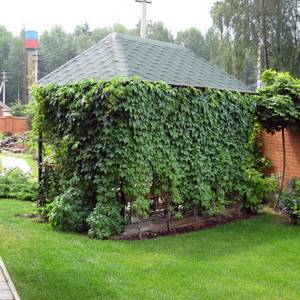
Hop
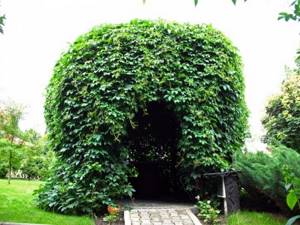
In the fall, this climbing vine freezes completely, but comes back to life in the spring. It grows rapidly and very quickly covers a large area. At the beginning of summer, bright green leaves adorn it, and in autumn, a huge number of light green cones appear on the plant, like a decorative decoration. This type of perennial is a good alternative for those who are bored with flowers and whimsical plants.
Evergreens
Among the evergreen perennial plants, ivy, hops and virgin grapes have gained particular popularity. They do not have elegant fragrant flowers, but stand out with wonderful lush foliage.
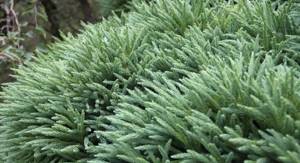
These plants have a lot of foliage
Ivy
Unpretentiousness and frost resistance are the main differences between ivy. In addition to these qualities, the liana has:
- rapid growth, after 2–3 years it is able to cover the entire gazebo (ivy grows up to 30 m long);
- can grow on any soil and in any area (lowlands, highlands);
- tolerates sun and shade equally well;
- To move upward, ivy does not need support; its shoots are able to “cling” to a flat surface.
Planting ivy is easy. In the spring, shoots with 2-3 buds are planted in holes with organic matter, up to 30 cm deep. Over the summer, they take root and gain strength. After planting, young seedlings need moderate watering and mandatory mulching in the winter.
Hop
Hops also grow quickly, but require additional support. It can be called “capricious” in its care. Without proper feeding (every two months), the vine can be susceptible to various diseases, which significantly affects the appearance of the plant. The perennial loves abundant watering and loosening, prefers diffused light.
Hops bloom with light green cones, which can be collected in the fall, dried and used as a cough medicine all year round.
Maiden grapes
Maiden grapes have carved and large leaves. It is especially pleasing with its lush green color in the spring-summer season and brings red tones of all shades into the dull autumn period. Shoots can grow up to 20 m. Among the main distinctive features, we note the following:
- the grapes are resistant to freezing (have dense thick roots that go deep into the soil);
- unpretentious in care (almost the entire growing period does not require special feeding);
- grows in any soil, being content with even a tiny piece of land;
- fast growing plant.
It blooms in summer with inconspicuous flowers that turn into small decorative berries (without fertilization by pollen). This is where its name comes from - virgin, maiden. Seedlings can be planted both in spring and late autumn. Requires moderate watering. The main condition is to prevent the soil from drying out for a long time.
Perennial frost-resistant plants
Don’t forget about plants that can decorate the gazebo all year round, including in winter. This includes a whole range of climbing perennials. For example, Echinocytis or, as it is also known, “mad cucumber”. Although considered by some to be a true weed, it can quickly and beautifully weave throughout an arbor.
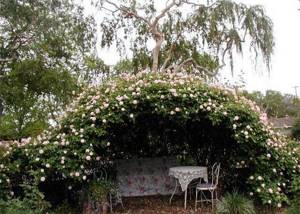
However, it has several disadvantages. Having a spicy smell, it attracts a large number of bees. As a result, everything can end in bee stings. So think about whether it's worth the risk. Although if you keep bees, then this is a pretty decent option.
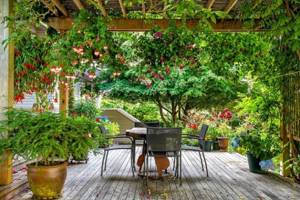
It is also worth mentioning evergreen ivy. It will decorate the gazebo literally all year round. It always has bright foliage, which will provide the open gazebo with enough shade for relaxation. Another spectacular perennial plant is Chinese lemongrass. This distinct citrus aroma will fill the area with a pleasant aroma. The decoration on Chinese lemongrass changes from green to yellow-orange until late autumn. These and many others can be used as climbing plants for perennial arbors.
Top Climbing Plants for Home Decor
climbing roses
Climbing roses are real queens among fast climbing plants for a gazebo. All summer long, lush flowers decorate the garden. There are many re-blooming modern varieties. Roses love warmth and a lot of light. Place the gazebo directly under the sun and then the blooming garden will become your source of inspiration!
Gardeners are pleased with the climbing rose due to its unpretentiousness. Good watering and fertilizers are the whole secret of caring for the plant. One of the most popular types is New Dawn. It quickly grows throughout the gazebo and delights the owners with pale pink flowers. The variety is winter-hardy, but in frosty weather it is better to cover the flowers. New Dawn grows evenly in width and height, creating a unique atmosphere in the garden.
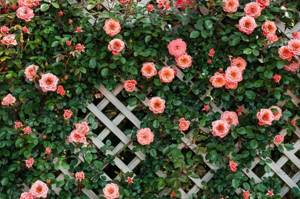
Climbing roses.
Wisteria
A flowering tree has a dense trunk, but this does not prevent it from decorating, for example, the roof over the porch of a house. The plant blooms profusely and is not difficult to care for. Wisteria needs frequent watering only in the first year, and then in extreme heat. Experienced gardeners recommend mulching the plant and sometimes adding compost.
Among climbing plants for a gazebo, Wisteria can be called fast-growing and perennial, but not winter-hardy. If the plant survives the frosts during its first winter, it will produce new shoots in the spring.
Wisteria (another name) grows by twisting, but this must be strictly monitored. The plant looks much more beautiful if you let it spread its shoots to the sides. To do this, you need to direct them in the right direction in time. If this is not done, Wisteria may suffocate itself or damage your home decor. With proper care, wood creates a unique atmosphere.
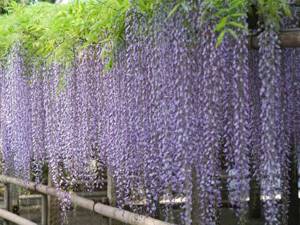
Wisteria.
Clematis
Climbing plants for a gazebo are often chosen for photos. Their best titles are searched all over the Internet. Clematis (the Buttercup family) is always found in the top queries of search engines.
The fast-growing vine can grow up to 3 meters, so it needs strong support. The plant has no petals, only individual cups of 4-7 leaves, painted in different colors. Clematis stand out from the climbing ones in that they produce an unprecedented number of shoots. The more there are, the more abundant the flowering will be. With proper deep planting, the plant grows more and more every year and produces lush flowering, creating a real flower paradise in the garden!
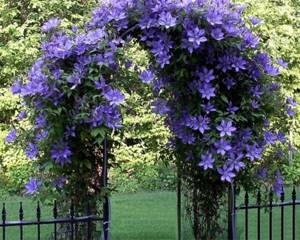
Clematis.
Akebia
The plant is often called chocolate vine. In the East it can grow up to 12 meters, but in our harsh climate Akebia grows smaller in size. There are 2 types of Akebia: quintuple and trifoliate. It is quite simple to distinguish them: the first leaves on the stalk are actually arranged in the shape of a five at the same distance from each other. Akebia trifoliata grows up to 25 meters and in the fall pleases with blue lavender colored fruits.
b68ad19485c9ad5dd61f64f6ba955315.jpe
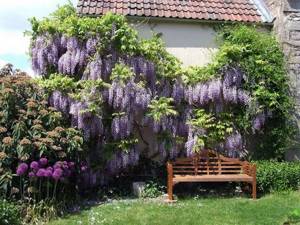
b3d972016122cb3957285ec2ecced228.jpe
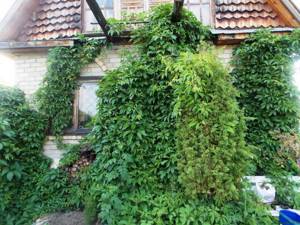
The plant was nicknamed chocolate vine for its spicy aroma, reminiscent of sweetness. This is not its only advantage. An unpretentious plant to care for, it requires fertilization with compost at the initial stage.
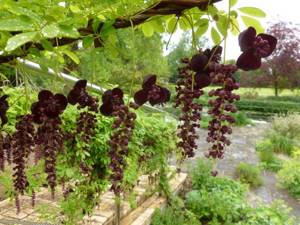
Prince
The plant is suitable for those gardeners who want to make a gazebo out of climbing plants with their own hands. Here you definitely won’t need the advice of experienced gardeners, because Knyazhik is one of the most unpretentious vines to care for. In country houses it is often planted to cover an unsightly wall or to create a “hedge”.
Prince.
Climbing Prince is loved in Russia for its excellent winter hardiness. Its flowering can only be seen on last year's shoots and occurs in May-June. Prince's flowers come in simple and double flowers of any shade: white, blue, pink, etc. Many consider the plant to be elegant and call it a “gardener’s classic.” When planting a plant, you don’t have to worry about low temperatures. Your efforts will definitely pay off with many years of flowering!
